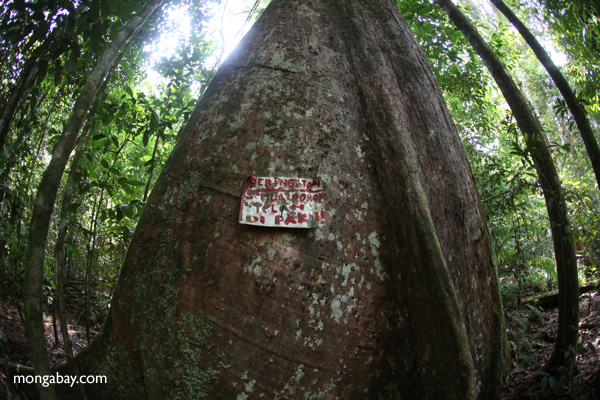
Sign warning that a tree is spiked to protect it from illegal logging in Indonesia’s Gunung Palung National Park. Photo by Rhett Butler.
While vast areas of wildlife habitat have been set aside in protected areas in recent decades, many reserves continue to suffer from illegal encroachment, logging, mining, and poaching. The recent spasm in elephant and rhino poaching within African parks merely underlines the problem.
Yet research has shown that people — provided they have a vested interest in safeguarding protected areas — can be a strong deterrent to illegal activities. For example, some of the best protected forests in the Amazon basin are those that are inhabited by indigenous people, rather than those managed distantly by conservation agencies. In Madagascar, the splitting of entrance fees between the national parks management authority and local villages has helped spur community vigilance against illegal activities.
But indigenous people and local communities aren’t the only ones with a presence in and around protected areas — scientific researchers often spend months, years, or even decades working deep inside conservation zones. They may be accompanied by a cohort of guides, field assistants, cooks and others.
Intuitively, it would seem that scientists’ presence in a protected area would help safeguard it from illegal activities. But according to a new paper published in Trends in Ecology & Evolution, no one has definitively shown that to be the case.
The paper, authored by William F. Laurance of James Cook University in Cairns, Australia, reviews some of the potential conservation benefits and detriments of the presence of field researchers. On the upside, Laurance notes that researchers’ presence can boost support for the establishment, expansion, or maintenance of protected areas. Scientists can also actively deter poachers and encroachers while providing needed employment for local people, some of whom may have formerly been hunters, illegal loggers, or encroachers. Local field assistants may go on to become researchers or conservationists themselves. Better informed and better linked to international advocates, they may be more able to forge a stronger stance against outsiders attempting to expropriate their lands, according to Laurance, who cites an example in New Guinea.
“In Papua New Guinea, field researchers have helped indigenous communities respond to logging and mining companies seeking access to their lands, so that the communities can judge the promises of financial gain more realistically,” he writes.
Meanwhile research facilities can complement or augment ecotourism initiatives, attracting nature enthusiasts who want to see science in action or take advantage of trail systems established by researchers.
Yet the presence of researchers is not necessarily a panacea for conservation. Poaching, encroachment, and illegal mining and logging continue in many areas in spite of the presence of field researchers. Overzealous scientists bent on strict protection — and perhaps lacking local cultural and political context — may alienate themselves and their projects from the local community, spurring backlash, in some cases even leading to, or exacerbating, opposition to the conservation area. There are even cases of directly harmful impacts of field research on wildlife, including spreading disease, like the chytrid fungus that is killing amphibians around the globe; causing wildlife to change their foraging and feeding habits; and stressing and outright killing animals through mark–recapture studies and biological collecting.
 Hypothetical relation between research activity and its benefits for protected areas and their biodiversity. Photograph reproduced, with permission, from W.F. Laurance. |
Evaluating these concerns, Laurance hypothesizes that the impact of research on biodiversity values might be nonlinear, with benefits to biodiversity increasing with higher researcher activity until they reach a point where additional researcher activity becomes detrimental to the environment. But Laurance concludes that more studies are needed to really understand how field research impacts biodiversity conservation. If the benefit is indeed mostly positive, as he believes, “maintaining a long-term research presence could be one of the more effective ways to help safeguard imperiled protected areas.”
“Parks with exceptional biodiversity values might merit more research funding on this basis alone. In an era of increasing financial austerity, we must carefully weigh the potential implications of reducing research in our embattled protected areas.”
CITATION: William F. Laurance. Does research help to safeguard protected areas? Trends in Ecology & Evolution, 25 February 2013 10.1016/j.tree.2013.01.017
Related articles
